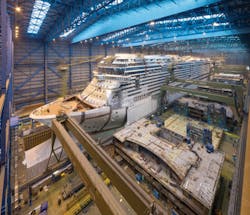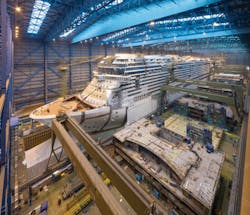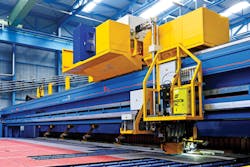HANNOVER, GERMANY – A joint project led by Laser Zentrum Hannover (LZH), together with electronics manufacturer Held Systems Deutschland (Heusenstamm, Germany), industrial laser maker Laserline (Mülheim-Kärlich, Germany) and shipbuilder Meyer Werft (Papenburg, Germany), is working to establish robust, pure laser welding processes for steel sheet thicknesses up to 30 mm. For this purpose, the team members are bringing diode laser beam sources to peak performance.
Processes for joining maritime steel components have great development potential in terms of production costs and productivity (FIGURE 1). The frequently used submerged arc welding process is comparatively slow and involves significant workpiece distortion, and an alternative process called laser-arc hybrid welding requires labor-intensive edge preparation and is not very flexible.
FIGURE 1. New laser welding processes will make welding of thick metal sheets in shipbuilding more efficient and less expensive. (Copyright: Meyer Werft/M. Wessels)
For large steel sheet thicknesses ranging from 12 to 30 mm in particular, no method has been able to prevail against submerged arc welding. Recognizing this, the project members want to develop robust, pure laser welding processes for thick metal sheet welding in the maritime sector. In the project dubbed Thick Metal Sheet Welding by High-Power Diode Lasers for Maritime Applications (DIOMAR), Laserline will develop new diode laser beam sources with maximum output power up to 60 kW in continuous-wave mode. The aim of the DIOMAR project is to achieve high-quality joints with high welding speeds, and the partners want to reduce the costs for edge preparation and the amount of additional material compared to existing joining methods (FIGURE 2).
FIGURE 2. The aim of the DIOMAR project is to establish new laser welding processes based on high-power lasers in the maritime sector. (Copyright: Meyer Werft/I. Fiebak)
The application-oriented development takes place in parallel in a laser laboratory and in a shipyard-like test environment, making it possible to quickly test, evaluate, and optimize processes.
For more information, please visit www.lzh.de.


